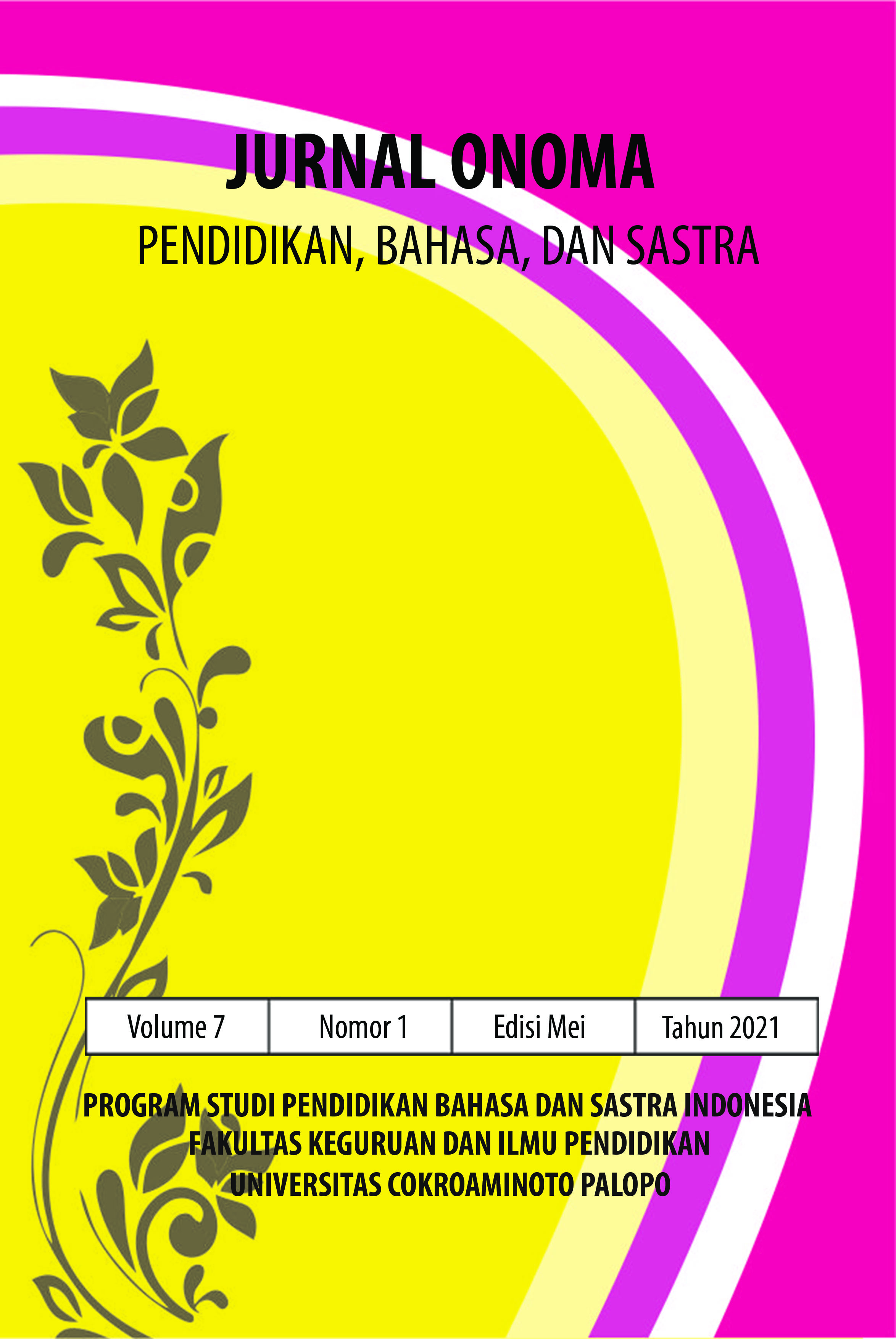Applying Blended Learning To Teach Vocabulary To Fourth Semester Students For English Department Students At Christian University Of Indonesia Toraja
https://doi.org/10.30605/onoma.v7i1.1409
Keywords:
Blended learning, teaching, vocabularies, edmodo, zoom applicationAbstract
The goal of the research is to know the effect of blended learning applied in teaching vocabularies for the fourth semester students. The research used qualitative method. The subject of the research is lecturer and fourth semester students at Toraja Christian University of Indonesia. The data collected by using edmodo as a media that used in pretest and posttest and zoom application used presented. In the research has effective indicator in teaching process. After applying blended learning, the result showed raised score, it can be classified excellent is 4 percent, very good is 28 percent , and fair is 44 percent, and poor is 1 percent
Downloads
References
Bower, M., Kenney, J., Dalgarno, B., Lee, M. J. W., & Kennedy, G. E. (2013). Blended synchronous learning: Patterns and principles for simultaneously engaging co-located and distributed learners. 30th Annual Conference on Australian Society for Computers in Learning in Tertiary Education, ASCILITE 2013, August 2017, 92–102.
Broughton, G., Brumfit, C., Flavell, Hill, P., & Pincas, A. (2003). Teaching English as Foreign Language. 0–49.
Djiwandono, P. I. (2020). How Samr-Based Vocabulary Teaching Shapes Vocabulary Learning Strategies. Teaching English with Technology, 20(4), 41–58. http://www.tewtjournal.org
Ekici, D. I. (2017). The Use of Edmodo in Creating an Online Learning Community of Practice for Learning to Teach Science. Malaysian Online Journal of Educational Sciences, 5(2), 91–106.
Evenddy, S. S., & Hamer, W. (2016). Edmodo As a Media To Teach Vocabulary. Sutrisno Sadji Evenddy & Welliam Hamer The Journal of English Language Studies, 01(01), 26–34. https://doi.org/10.30870/jels.v1i1.685
Faisal, I. A. (2019). The use of Edmodo: Its impact on learning and students’ attitudes toward it. Journal of Information Technology Education: Research, 18, 319–330. http://search.ebscohost.com/login.aspx?direct=true&db=e095mww&AN=532124&site=ehost-live
Gay, E., & Sofyan, N. (2017). the Effectiveness of Using Edmodo in Enhancing Studentsâ Outcomes in Advance Writing Course of the Fifth Semester At Fip - Ummu. Journal of English Education, 2(1), 1–11.
Halil, N. I. (2020). The Effectiveness of Using Edmodo as an Online Learning Platform in Covid-19. Jurnal Penelitian Dan Pengkajian Ilmu Pendidikan: E-Saintika, 4(3), 284. https://doi.org/10.36312/e-saintika.v4i3.316
Inayati, A. M., Asib, A., & Drajati, N. A. (2019). Edmodo in English Language Learning: A Review of Recent Studies. Jurnal Ilmiah Kependidikan, 12(2), 111–122.
Khodary, M. M. (2017). Edmodo Use to Develop Saudi EFL Students’ Self-Directed Learning. English Language Teaching, 10(2), 123. https://doi.org/10.5539/elt.v10n2p123
Laili, R. N., & Nashir, M. (2018). The Effect of Blended Learning by Using Edmodo in Teaching English for Nursing Students. Indonesian Journal of Curriculum and Educational Technology Studies, 6(2), 71–76. https://doi.org/10.15294/ijcets.v6i2.26509
Machumu, H. J., & Zhu, C. (2019). Building a Conceptual Relational Model Among Blended Learning Aspects in K-20 Education. March 2020, 21–39. https://doi.org/10.4018/978-1-7998-0242-6.ch002
Marin, A., & Victoria, I. (2016). Table of Contents International Journal of Mobile and Blended Learning. 8(1), 51–68.
Musskopf, Â., & Barbosa, D. N. F. (2018). EDMODO: Experiencing a global education network. Communications in Computer and Information Science, 870(July), 131–141. https://doi.org/10.1007/978-3-319-95522-3_12
Parer, A. G. (2016). the Use of Edmodo Website To Improve Students.
Tosun, S. (2015). The Effects of Blended Learning on EFL Students’ Vocabulary Enhancement. Procedia - Social and Behavioral Sciences, 199, 641–647. https://doi.org/10.1016/j.sbspro.2015.07.592
Virgili, U. R. I. (2015). María del Mar Gutiérrez-Colon Plana Juan Francisco García Bascuñana.
Wang, F. L., Fong, J., & Kwan, R. C. (2009). Handbook of research on hybrid learning models: Advanced tools, technologies, and applications. In Handbook of Research on Hybrid Learning Models: Advanced Tools, Technologies, and Applications. https://doi.org/10.4018/978-1-60566-380-7
(Amil et al., 2020; Bower et al., 2013; Broughton et al., 2003; Djiwandono, 2020; Ekici, 2017; Evenddy & Hamer, 2016; Faisal, 2019; Gay & Sofyan, 2017; Halil, 2020; Inayati et al., 2019; Khodary, 2017; Laili & Nashir, 2018; Machumu & Zhu, 2019; Marin & Victoria, 2016; Musskopf & Barbosa, 2018; Parer, 2016; Tosun, 2015; Virgili, 2015; Wang et al., 2009)
Downloads
Published
How to Cite
Issue
Section
License
In submitting the manuscript to the journal, the authors certify that:
- They are authorized by their co-authors to enter into these arrangements.
- The work described has not been formally published before, except in the form of an abstract or as part of a published lecture, review, thesis, or overlay journal.
- That it is not under consideration for publication elsewhere,
- That its publication has been approved by all the author(s) and by the responsible authorities – tacitly or explicitly – of the institutes where the work has been carried out.
- They secure the right to reproduce any material that has already been published or copyrighted elsewhere.
- They agree to the following license and copyright agreement.
License and Copyright Agreement
Authors who publish with Onoma Journal: Education, Languages??, and Literature agree to the following terms:
- Authors retain copyright and grant the journal right of first publication with the work simultaneously licensed under Creative Commons Attribution License (CC BY 4.0) that allows others to share the work with an acknowledgment of the work's authorship and initial publication in this journal.
- Authors are able to enter into separate, additional contractual arrangements for the non-exclusive distribution of the journal's published version of the work (e.g., post it to an institutional repository or publish it in a book), with an acknowledgment of its initial publication in this journal.
- Authors are permitted and encouraged to post their work online (e.g., in institutional repositories or on their website) prior to and during the submission process, as it can lead to productive exchanges, as well as earlier and greater citation of published work.

















